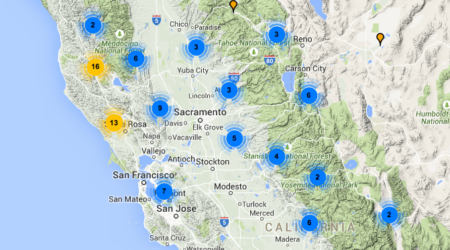From “filled with happiness” to “boiling over with rage,” much of the language we use to describe emotions depicts them as internal forces, waiting to be unleashed.
Yet according to Iris Mauss, Associate Professor of Psychology at UC Berkeley, our feelings are rarely (if ever) entirely internal; instead, they drive us toward external action, whether taking deep breaths to reduce stress or making a face. “Humans don’t usually just have an emotion and go with it,” Mauss says. “Rather, we almost always—and one might argue always—try to do something with that emotion. We may want to alter how we feel, we may want to alter how we act, or we may want to alter the physiological aspects of emotion.”
Mauss runs UC Berkeley’s Emotion and Emotion Regulation Lab, which is dedicated to studying how people try to shape emotions and their expression. This year, Mauss’s research on emotion earned her an award from the American Psychology Association for an early career contribution to psychology.

Even within psychology, emotions have long been considered “unscientific,” Mauss says. The study of emotion was pioneered in the 1960s by Paul Ekman, a researcher at the University of California, San Francisco who is now on the editorial board of the Greater Good Science Center at UC Berkeley. In a series of groundbreaking studies, Ekman traveled to remote places such as Papua New Guinea and showed the local residents photographs of facial expressions, to ascertain whether emotions are universally human and based in evolution and biology.
Ekman’s research was inspired in part by Charles Darwin, whose 1872 work The Expression of the Emotions in Man and Animals argued that different species and cultures use the same facial expressions to show similar internal experiences. Ekman found that his subjects recognized the emotions in the photographs at a rate that exceeded chance, and he concluded that emotion has at least some universal element. His work set off an ongoing controversy about the extent to which emotions are biologically or culturally constructed.
Ekman subsequently identified six basic emotions that he argued have discrete biological functions. The emotional expression of disgust, for example—which includes wrinkling the nose and curling the upper lip—is thought to be rooted in the biological need to expel something harmful from the body. Some psychologists argue that this biological system has been co-opted by social versions of the same emotion, so that we make the same face when experiencing moral disgust.
Subsequent researchers, including Berkeley psychologist Dacher Keltner, have built on Ekman’s research to suggest that other, more dynamic movements, such as posture, offer greater insight into emotion than a frozen facial expression alone. For example, Keltner has identified the act of tilting the head as part of the emotional response of embarrassment.
The field of “affective science” now spans a variety of disciplines, including anthropology, sociology, and history. Affective neuroscience focuses on the role of neurotransmitters such as dopamine and serotonin in producing emotion, whereas affective historians such as Barbara Rosenwein focus on how emotion has been culturally constructed over time. The view of emotions as pent-up forces stems in part from the ancient theory of humors, which identified four bodily fluids (black bile, yellow bile, phlegm, and blood) as the source of a person’s affective state.
Mauss’s lab measures emotion in a variety of ways: by gauging physiological variables such as heart rate, skin conductance, and blood pressure; asking participants to describe their feelings in questionnaires and diaries; and videotaping them to observe their facial expressions and body movements. In the latter case, the videos are rated by independent teams of coders who look for how intensely participants outwardly show emotion. For example, if the study seeks to measure amusement, the researchers code for everything from a blank face to hysterical laughter.
The lab has found that how people think about emotions has an impact on their well-being. For example, in “Desperately Seeking Happiness,” a 2014 paper published in the Journal of Social and Clinical Psychology with graduate student Brett Ford and other researchers, Mauss found that people who place a high value on happiness actually tend to be more depressed. In the initial study, participants in remission from major depressive disorder were asked to respond to questions assessing how much they valued happiness (based on agreement with statements like “happiness is extremely important to me”). The degree to which they prized happiness correlated with increased depressive symptoms, even when controlling for a variety of factors, such as overall neuroticism, demographics, and relationship status.
One follow-up study found that a higher value placed on happiness was also a risk factor for developing depression, and another recent follow-up study found that the extreme valuing of happiness was also associated with (and even predicts) bipolar disorder. Such findings suggest that targeting emotional values — i.e. changing how people value happiness — might improve patients’ outcomes, Mauss says.
Mauss’s Lab also explores the relationship between the beliefs people hold about their emotions and what their bodies are doing. “It turns out that those beliefs and experiences are quite different from what’s actually going on [physically],” she says.
For example, Mauss conducted a study at Stanford in which participants were asked to give an impromptu speech in front of a camera. Some participants were highly socially anxious, others not at all. After the speech, they were asked to rate how anxious they had been on a ten-point scale; unsurprisingly, the highly anxious people listed numbers at the top of the scale, while the non-anxious people said they were at the bottom. Moreover, while the non-anxious group said they felt few physical symptoms, the highly anxious group reported that their hearts were racing uncontrollably, their palms were drenched in sweat, and their faces were blushing bright red—the classic signs of anxiety.
However, the lab had measured the participants’ actual physiological responses, and found that there was no difference between the two groups. Everyone showed the same increases in heart rate, skin conductance level, and facial blushing. “They were identical on every single measure,” Mauss says. “It seemed to us like the experience of those physiological symptoms was highly cognitively or socially constructed. It was driven by how anxious a person felt, and not how their bodies were actually behaving.”
For people with a high degree of social anxiety, the perception that they are blushing and sweating feeds into a “vicious cycle” of feeling socially inadequate. Simply knowing that everyone experiences the same physiological symptoms could help overcome the cycle, Mauss says.
Researchers in the Emotion Lab and Emotion Regulation Lab also study the degree to which emotional regulation is automatic. From infancy, societies train their members to control their emotions in a certain way; children who start to cry may be immediately hushed. This process continues in adulthood through cultural signals. “All those social interactions and practices shape these automatic types of emotion regulation that we engage in without us usually being aware of them,” Mauss says.
To overcome the implicit challenges of studying automatic emotion regulation in a laboratory setting, Mauss uses priming methods, such as having participants complete a word-unscramble task with words related to emotion and control, then brings the subjects into an “emotionally evocative” situation to see how they respond. In one study, Mauss posed as an “annoying researcher,” reprimanding participants for their behavior and loudly eating potato chips and crinkling the bag. The results showed that participants who were primed to use emotional control actually experienced less anger, and were not aware that they had been influenced to do so.
In general, research has found that people who are effective at regulating their emotions tend to be healthier and less depressed than those who aren’t. One method thought to be helpful in this regulatory process is known as “cognitive reappraisal,” or reframing one’s emotional experience in a more positive light.
However, emotional control isn’t always a good thing. In a recent study, Mauss —together with former students Allison Troy and Amanda Shallcross—found that reappraisal works best when “self-regulating or changing yourself is the only option you have.” The lab gauged participants’ ability to regulate their emotions through cognitive reappraisal and categorized the types of stressors they had recently experienced as “controllable” (e.g. when responding to a problem at work) or uncontrollable (e.g. reacting to the death of a close friend). When participants were faced with uncontrollable stressors, having a greater ability for reappraisal did indeed make them less depressed. For the group that experienced controllable stressors, however, the outcome flipped: being good at regulating emotion was not just ineffective, but actually increased the risk of depression.
In other words, the key to healthy emotion regulation is understanding which contexts are better suited to reframing our feelings, and which require confronting an external situation. “I don’t think we should all be unemotional as we walk through life,” Mauss says. “Sometimes negative emotions can be very useful.”
To learn more about the Emotion and Emotional Regulation Lab, please see http://eerlab.berkeley.edu.



